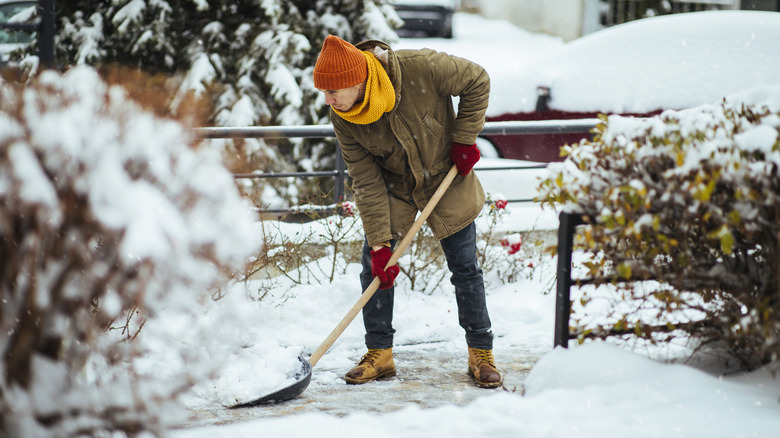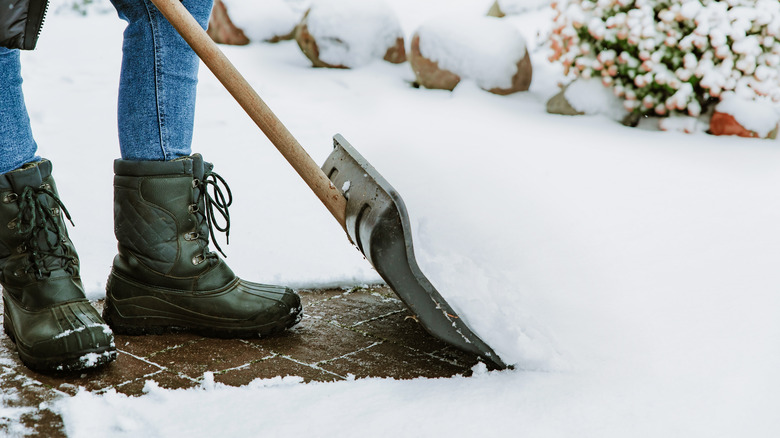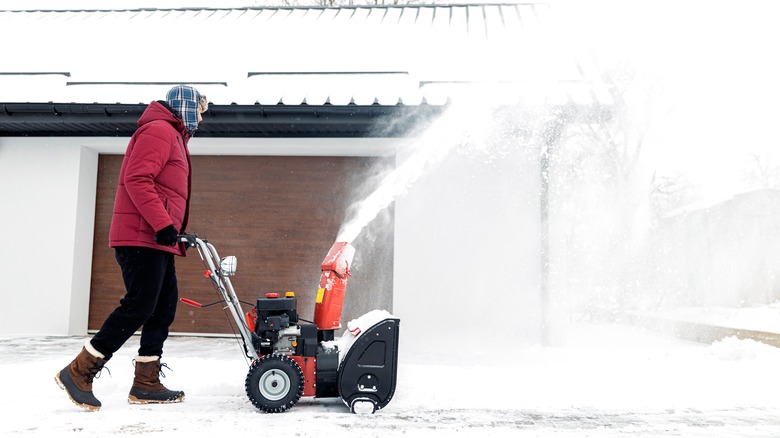The Crucial Snow-Shoveling Mistake That Can Cause Harm To Your Yard And Garden
If you dread shoveling snow and ice in the wintertime, you're not alone. You probably want to just finish the job as quickly as possible, flinging it wherever you can to clear the sidewalk and driveway before you end up with frostbite. However, you may not know that removing the snow carefully is an important process when caring for your lawn in winter so that it's lush in the spring. If you pile too much frozen material onto the grass, it could create a fungal infection or it could place stress on the lawn that causes it to struggle to recover and green up in the spring. The same problem can plague your garden when you are removing snow from patios or decks, where the piles end up on landscaping and on perennial garden plants near the home.
Falling snow that lands on top of the grass during the winter shouldn't harm the plants to any significant degree. Beyond adding moisture to the ground as it melts in warmer weather, it provides a layer of protection for the grass when temperatures are especially low during portions of the winter. However, should you pile extra snow onto the grass after shoveling the driveway and sidewalk, this extra weight and the compacting of the entire pile can be stressful for the lawn while adding too much moisture when it melts. If at all possible, select a spot to pile the snow that you are removing that isn't on the grass plants.
Salt-infused snow can also damage your lawn
Another problem with taking snow and ice off your sidewalk and driveway is that you or someone else may have tried to melt ice in these areas with salt. If this material ends up on the lawn where it can sit all winter, it can create significant problems for the grass the following spring. It can cause the plants to simply struggle to grow when the warmer weather rolls back around, leaving areas brown. As long as the concentration of the deicing salt is not too strong in the yard, the grass should slowly grow back on its own. However, a strong concentration can kill the plants, leaving bare spots near the sidewalks and driveways.
Ideally, you'll have a graveled or hardscaped area without any garden plants where you can pile the snow if it has salt in it. Do your best to remain on the concrete when moving the shovel across the snow. Even though the blade of the shovel often has a rubber guard on it and is not particularly sharp, you could damage your lawn by going past the edge of the driveway or sidewalk and inadvertently digging into the soil, tearing chunks of turf loose, and damaging the grass for the long term.
Using a snow blower may resolve the issue
While proper placement of shoveled snow can help ensure your grass remains healthy, using a snow blower to take care of snow removal can help the process as well. This is mainly due to the fact that you can use the adjustable chute to direct the snow in whatever direction you want. The machine allows you to direct it several feet away, spreading it along the entire path where you're walking, rather than piling it up in a single place as you often do with a shovel. Having the snow spread evenly across your grass prevents it from compacting over the top of the yard as can happen with piles from a shovel.
One danger to using a blower is that it picks up everything on the driveway and sidewalk and directs it onto your lawn. This can include gravel or deicing salt. Similarly to using a shovel to create a pile to the side of a garage or on a hardscaped area that doesn't have plants, you can direct any gravel or deicing salt into these areas with the snowblower as well. You could also select a two-stage or a three-stage snow blower that skims over the top of the sidewalk or driveway, leaving a little bit of snow down and hopefully not picking up other debris.


